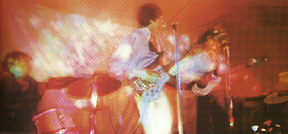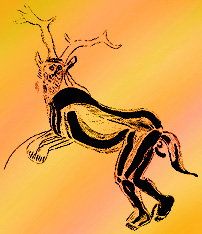|

by Dave Ward

Pink
Floyd performing in 1967
|
1967. Lights strobe relentlessly between electric blue and utter
blackness. The scents of incense, sweat and smoke mingle strongly.
But most of all the aural assault is inescapable: bashing, throbbing
rhythm so tuneful that it becomes tuneless and incomprehensible.
A crowd dances wildly on the floor below the stage. Just above,
a dark-eyed, beautiful young man on stage holds a guitar. He stares
intently at the frets, tweaking and slapping the strings, occasionally
sliding a silver Zippo lighter on the strings. Beside him stands
a lanky bassist with long, sweeping hair and a frightening stare
behind his magenta round-lensed glasses. The bassist is pressing
the bass strings directly against the pickups of his instrument,
producing an otherwordly musical blip. A little toward the back
stands a gentle-looking, angular-faced keyboardist with long hair.
The keyboard player half smiles to himself as he coolly stabs
out almost random-sounding chords and blocks of noiseful notes,
occasionally throwing in just fragments of a melody. Behind them
all, a dark, round-faced young drummer hunches behind his kit,
an intense look in his eyes as he pounds out abstract–but not
complex–rhythms. The noise is thick, overwhelming, and incredible.
Pink Floyd are performing "Interstellar Overdrive" while the lights
strobe disconcertingly and the audience writhes.
"It would not be too much to say that myth is the secret
opening
through which the inexhaustible energies of the cosmos pour into
human cultural manifestation," wrote Joseph Campbell in the first
major modern treatise on mythology, his 1949 book The Hero With A
Thousand Faces.
Pink Floyd have proven to be excellent–although almost always
unintentional–myth makers throughout their better than thirty
years of music. From the psychologically transformative concerts
in the London Underground to the vast arenas of The Division
Bell,
their live concerts have had profoundly mythic impacts on fans.
And from Syd Barrett's metaphoric journey past Neptune and Titan
to the reflective musings on a world of magnets and miracles,
the lyrics of Pink Floyd have explored, whether knowingly or not,
the human subconscious and preconscious in ways pop music seldom
can achieve.
Unfortunately, the very term "mythology" conjures up
negative
images to many. Dusty books. Absurd, childish tales of pagan gods.
Daft morality plays for children. Misleading, groundless bunk.
Mythology couldn't be further from that. "Mythology opens the
world so that it becomes transparent to something that is beyond
speech, beyond words, in short, to what we call transcendence,"
Campbell said in The Hero's Journey. In general, mythology is
anything which, whether factually "true"
or not, says something that is true to the human heart, and/or
which references something that transcends our experience as mortals.
Given such a definition, how could Pink Floyd fail as mythmakers?
They don't; in fact, they succeed wildly.
The Cave
Ritual
Let's return to that 1967 concert in the London Underground. The
stroble lights flicker madly, disconcerting everybody in the room.
The noise is a thick, dark blanket of disconnected melodies, echoing
and repeating, gradually changing to new ones, the rhythm a persistant
and unusual pounding steady four beats to the measure. It's an
assault on the senses of a kind that had never been seen before.
How does a boy become a man? How does a girl become a woman?
Ideally,
there is an event sometime during adolescence which shocks your
psyche and awakens the adult man or woman, somehow increasing
your awareness along the way. Changes come about by suffering
and gaining wisdom from that experience, so this event is almost
always frightening and painful.
Various cultures throughout history have had their own ways of
leading boys and girls to adulthood. The methods of frightening
and awakening the adult varied widely from culture to culture,
and seem brutal by today's standards, but the rituals were powerful
parts of each society, and they successfully made men of boys
and women of girls for thousands of years.
One popular example centers on a Cro Magnon cave in the French
Pyrenees. Upon approaching puberty, boys would be taken to the
cave and made to crawl into the small entrance. The entrance to
the cave has a long, extremely narrow passage. It can only be
crawled through, and after only a short distance there is no light
left whatsoever. The tight space, the utter blackness, and the
complete inability to tell where you are or where you are going
is psychologically overwhelming; many boys must have completely
panicked during the journey through this passageway.

The
"Sorcerer of Trois Frères"
|
At the end of the passageway, there is an enormous room with hundreds
of ancient cave drawings of animals on every wall. Immediately
in front of you upon exiting is a large drawing, both beautiful
and terrifying. The drawing depicts some sort of mythic animal
master who has a lion's body, elk's antlers, the eyes of an owl,
human legs, and the reproductive organs of a cat. Passing through
the passage way, experiencing such incredible claustrophobia and
fear, and then emerging to be received by Cro Magnon priests dressed
like the great painting of the antlered "Dancing Sorcerer"
must
have been a central event in the lives of boys, and surely must
have ultimately been a critical signpost to guide Cro Magnon boys
into manhood.
Jump forward in time, again to 1967, the London Underground. This
pounding visual and aural experience, including the other sensations
that accompanied the events, were something the modern world had
hardly seen. It was a new incarnation of the cave ritual, and
now the high priests were four young men of Cambridge.
Did they know they were creating an event that functioned much
like the ancient rituals that had once guided adolescents into
adulthood? Almost certainly not. The human subconscious instinctively
knows what you need, and tends to lead you there. These four young
men–Syd Barrett, Roger Waters, Richard Wright and Nick
Mason–just
made sounds they enjoyed. By Waters' own admission, they weren't
good musicians. But most likely, neither were most of the Native
Americans, Australian Aborigines or Scandanavian Saami who beat
the drums and sang the songs which once guided children to adulthood.
What matters is not so much whether we are aware of where we are
going, or how we get there–nor even whether we acknowledge that
we're on our way–but only that we do get there somehow.
Bibliography:
- The Hero With A Thousand Faces, Campbell,
Joseph; Princeton University Press, 1949
- The Hero's Journey: Joseph Campbell On His Life and
Work, Cousineau, Phil; Harper & Row, 1990
Dave Ward is editor of The Steel Breeze Pink Floyd news
service, and is also an avid student of mythology
and rituals. He manages an intimate mythology discussion forum,
Living Myth, which myth enthusiasts are welcome to
join. |


